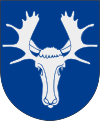Östersund Municipality
|
Östersund Municipality Östersunds kommun |
||
|---|---|---|
| Municipality | ||
|
||
 |
||
| Country | Sweden | |
| County | Jämtland County | |
| Seat | Östersund | |
| Area | ||
| • Total | 2,501.08 km2 (965.67 sq mi) | |
| • Land | 2,208.31 km2 (852.63 sq mi) | |
| • Water | 292.77 km2 (113.04 sq mi) | |
| Area as of January 1, 2014. | ||
| Population (December 31, 2016) | ||
| • Total | 61,745 | |
| • Density | 25/km2 (64/sq mi) | |
| Time zone | CET (UTC+1) | |
| • Summer (DST) | CEST (UTC+2) | |
| ISO 3166 code | SE | |
| Province | Jämtland | |
| Municipal code | 2380 | |
| Website | www.ostersund.se | |
Östersund Municipality (Swedish: Östersunds kommun) is a municipality in Jämtland County in northern Sweden. Its seat is located in Östersund, which is also the county seat of Jämtland County.
The present municipality was formed in 1971 by the amalgamation of the City of Östersund with five surrounding rural municipalities.
There are ten localities (or urban areas) in Östersund Municipality:
The municipal seat in bold
Swedish municipalities are responsible for government-mandated duties, and elections for the municipal council (kommunfullmäktige) are held every four years, parallel to the general elections.
Östersund gained a city council (stadsfullmäktige) in 1863, known as Östersunds stad, and each member was elected through a single-winner voting system. Sweden was democratized in the end of the 1910s and a more parliamentarian election system was introduced. Östersund continued to be governed by the burghers, unlike Sweden nationally. The dominating parties were the conservatives, the freeminded and the social democrats. The latter did become the single largest party in 1938 but due to a strong centre-right majority it remained in opposition. The only other party present in Östersund was the communists, though they had little support in the city, having entered the city council in 1922 and lost representation completely in 1930. The conservatives was by far the largest party and had a majority of its own with 18 seats in 1922. After the municipal elections of 1950 the situation had changed. The conservatives was the smallest party with 10 seats, the liberals (now represented by the Liberal People's party) had 11 and the social democrats 19. This was in contrast to the turnout on a national level, where the social democrats had been the dominant party for over a decade gaining e.g. 46 percent of the votes in the general elections of 1948. In 1952 a social democrat was appointed chairman of Östersund's governing body, due to the lack of political blocs and the strive for mutual agreements.
...
Wikipedia

